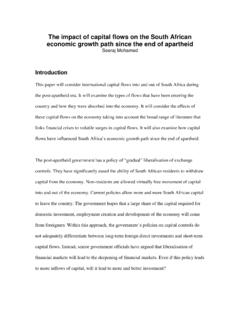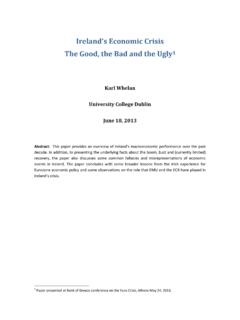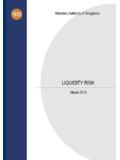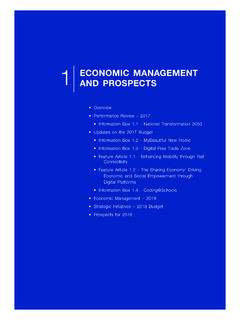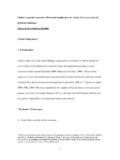Transcription of Fiscal Policy as a Tool for Stabilization in Developing ...
1 Background Note Fiscal Policy as a Tool for Stabilization in Developing countries Aart Kraay and Luis Serven The World Bank 1 Fiscal Policy as a Tool for Stabilization in Developing countries Background Note for 2014 World Development Report: Managing Risk for Development Aart Kraay and Luis Serven1 February 2013 The financial crisis of 2007/2008, the subsequent great recession in rich countries , and its propagation to Developing countries has sparked a renewed interest among policymakers and researchers in the role of Fiscal Policy as a potential countercyclical tool. This note first reviews the state of the empirical evidence on the effectiveness of discretionary countercyclical Fiscal Policy , with a particular emphasis on Developing countries .
2 On the whole, successful Fiscal interventions of this type have been rare in the Developing world. The note also reviews briefly a few contrasting experiences of success and failure in industrial and Developing countries . It concludes with several recommendations motivated by past experience that policymakers should consider before adopting any Fiscal responses to the current crisis. Fiscal Policy Is Procyclical in Developing countries There is strong evidence that Fiscal Policy has been procyclical in Developing countries . Fiscal expansions tend to take place in good times, and not during bad times when they might play some role in smoothing output declines.
3 This applies to a variety of measures of Fiscal Policy including total expenditure, the share of total expenditure in GDP, public consumption and public investment (with the latter being the most procyclical of all). 2 Fiscal procyclicality in Developing countries arises from both the weakness of automatic stabilizers and the procyclical bias of discretionary policies. While in industrial countries countercyclical discretionary Policy contributes to dampen aggregate fluctuations, in Developing economies discretionary Policy is usually procyclical. In addition, in most Developing countries automatic Fiscal stabilizers such as income taxes and transfer programs built into the Fiscal system are too small to have a significant smoothing effect on aggregate In contrast, these automatic stabilizers play an important role in generating increases in government spending and reductions in tax revenues during downturns in industrial countries .
4 1 Development Research Group, the World Bank 1818 H Street NW Washington DC 20433, . This note draws on, extends, and updates our earlier briefing note on this topic prepared for World Bank President Robert Zoellick in December 2008 The views expressed here are the author's, and do not reflect those of the World Bank, its Executive Directors, or the countries they represent. 2 See Gavin and Perotti (1997), Kaminsky, Reinhart and V gh (2004), Ilzetzki and V gh (2008), and Calder n and Schmidt-Hebbel (2008). 3 Suesc n (2007) shows that automatic tax stabilizers are much weaker in Latin America than in industrial countries .
5 2 The procyclical bias in Fiscal Policy reflects underlying fundamental challenges facing Developing countries . Research suggests that two main sets of factors account for this procyclicality of discretionary Fiscal Policy : (i) the inability of Developing countries to access external finance to pay for Fiscal expansions during downturns4, and (ii) political economy problems that contribute to an overspending of public revenues when they are abundant in good Such fundamental factors are difficult to overcome in the short run, suggesting deep underlying limits on the ability of most countries to generate successful Fiscal responses to the current Fiscal expansions are difficult to reverse.
6 If governments commit to unsustainably large spending programs during recessions as a countercyclical device, these may be very difficult to reverse when times improve, threatening Fiscal sustainability in the long This is why automatic stabilizers in the form of lower tax takes and larger transfer payments during recessions are viewed as a more sustainable approach to countercyclical Fiscal Policy in industrial But, as already noted, the difficulty for Developing countries is that most have very weak tax and transfer schemes and so the effectiveness of automatic stabilizers is limited. Emerging evidence suggests that in the recent crisis, Developing country Fiscal responses have departed from past patterns and been more countercyclical.
7 Unlike before most past crises, many Developing countries had reasonably sound macroeconomic fundamentals and Fiscal "space" in the mid-2000s. Didier, Hevia, and Schmukler (2011) argue that, when the crisis struck, this provided them with greater flexibility to pursue countercyclical Fiscal responses. This stands in contrast with forced Fiscal contractions that have often accompanied past crises. However, it is too soon to say whether this recent experience means a permanent break from the past. Fiscal Multipliers in Developing countries are On Average Small, But Difficult to Predict The evidence discussed above on the procyclicality of Fiscal Policy has primarily been based on documented positive correlations between Fiscal variables and output over the business cycle.
8 While these correlations are useful stylized facts, they do not isolate the causal effect of changes in Fiscal variables such as government spending or tax revenues on economic activity, the question of Fiscal multipliers. Understanding the size of 4 Kaminsky, Reinhart and V gh (2004) refer to this phenomenon as "when it rains, it pours". 5 See for example Tornell and Lane (1999) for a tragedy-of-the-commons argument for overspending bias when many powerful interest groups compete over public spending. Fatas and Mihov (2002, 2007) find that the volatility of Fiscal Policy is substantially higher in countries with weak institutions.
9 6 Calder n and Schmidt-Hebbel (2008) find strong empirical support for both institutional failures and credit constraints as determinants of countercyclical Fiscal Policy in emerging economies. 7 In this light, IMF (2008) concludes that for emerging economies "discretionary Fiscal Policy does indeed appear to do more harm than good". 8 See for example Beetsma (2008). 3 such multipliers is crucially important for policymakers contemplating countercyclical changes in discretionary Fiscal Policy in response to economic downturns. Estimating Fiscal multipliers is complicated by a standard identification problem. To the extent that governments choose to increase spending or reduce taxes in response to adverse macroeconomic shocks, the simple correlation between Fiscal variables and output will understate the causal effect of the former on the latter.
10 A large empirical literature, primarily using data from the United States, has sought to address this statistical challenge through a variety of creative identification strategies. For example, many authors have followed Barro (1981) in relying on exogenous fluctuations in military spending in the United States during major wars to estimate domestic spending Other papers have relied on specific political and/or institutional features of the determinants of government spending, typically at the subnational level, to isolate a credibly exogenous source of variation in spending that can be used to estimate Fiscal Yet other papers, following the lead of Blanchard and Perotti (2002)










